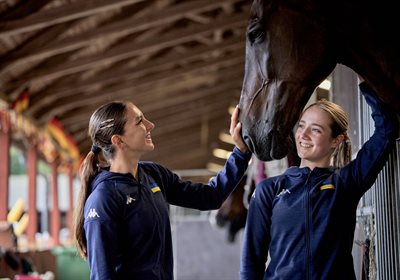Danish combination Nanna Skodborg Merrald and Atterupgaards Orthilia at the FEI Dressage European Championships 2021. © FEI/Liz Gregg
By Sophie Baker
The FEI’s helpful guide…
Ever wondered how Dressage works? To non-horsey people (or even just non-Dressage people!) it’s almost impossible to understand what’s going on. And if you don’t understand it, how could you possibly appreciate it?
So whether you’re new to horses, new to Dressage, or trying to impress someone horsey with your understanding of everything equine, here’s a basic guide to how Dressage works.
First thing’s first. It’s not like tennis where you have to beat any particular opponent directly. Everyone competes and you place somewhere in the field of athletes, more like swimming or running. Dressage judging guidelines and directives are published here.
Judges are the ones who give your marks, and although it is a somewhat subjective sport, they are all highly trained. Theoretically, five judges should all give the same combination similar marks – although what one judge sees from one position might be slightly different to what someone sees from another position. Just like in football or rugby where they have linesmen!
Secondly, each movement is marked out of 10. This is what gives the rider an overall score, and from there, a percentage is worked out. The rider with the highest percentage is the winner of their class.
Each movement is marked out of 10…
At high levels and international shows, there’s normally more than one judge but at most local shows you will only have one. If there’s only one, they’ll be at C but if there’s more, they could be at B, E, and A as well. If there are multiple judges, the average of the scores is taken – and in some instances, the highest and lowest scores for each movement are discarded to ensure fair and even judging.
For each movement, the respective marking scale looks something like this:
- 0 = not performed
- 1 = very bad
- 2 = bad
- 3 = fairly bad
- 4 = insufficient
- 5 = sufficient
- 6 = satisfactory
- 7 = quite good
- 8 = good
- 9 = very good
- 10 = excellent
So if a mark of 7 is awarded for a specific movement, that means it was performed fairly well.
If the test being ridden is set to music, there will also be an artistic score which adds to the overall percentage.
If you make a mistake, you can still do well at Dressage. Although a mistake will lead to a bad score for one mark, you can sometimes make it up by doing really well in other movements, seeing as the overall percentage is what counts. So if you forget where you’re going or do something silly, it’s best to gather yourself and continue like nothing happened.
But that doesn’t mean you can’t get eliminated or have penalties! There are a few things to keep in mind here. If you forget where you’re going or ride the wrong thing, you’ll get -2 for that movement. In most places, if you go wrong a second time you’ll lose another 4 marks (so 6 in total) and if you do it three times, you’ll be eliminated.
If your horse steps out of the arena, you’ll be eliminated. The same goes if you fall off! And if your horse is resistant enough (spooking, rearing, napping etc) that you can’t continue the test for around 20 seconds, you can be eliminated too.
Hopefully that guide to the basics makes it all a little clearer for you! Check out the FEI’s dedicated Dressage page on Facebook…
This article was first published by the FEI and is re-produced here with its permission.
READ THE LATEST NEWS ARTICLES HERE









